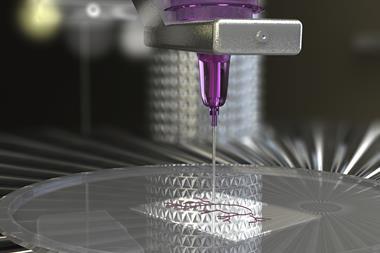A new ‘super-shielded’ carbene is stable in liquid water solutions. The US team that made the carbene claims that it ‘unambiguously confirms’ that it is possible to generate carbenes in an aqueous environment – validating a hypothesis put forward almost 70 years ago by the famed organic chemist Ronald Breslow.
Carbenes contain a carbon atom that has two non-bonded valence electrons. In general, this makes them highly reactive and short lived. Their unique chemistry makes carbenes particularly useful in catalysis.
In the late 1950s, Breslow proposed that vitamin B1 was able to promote various biochemical reactions via the formation of a fleeting carbene species. But this was a controversial idea as carbenes are not generally thought to be compatible with water. While much indirect evidence gathered over the years has led the scientific community to accept Breslow’s hypothesis, until now no carbene had been directly observed in an aqueous solution.

Vincent Lavallo, whose lab at the University of California, Riverside isolated the new water-stable carbene, explains that the project began almost a decade ago. ‘We design catalysts as part of my research programme, and [carbenes] often can be used as supporting parts of catalysts as ligands,’ he explains. ‘And this one turns out to be a horrible ligand – doesn’t bind anything, doesn’t react with anything. But that’s why we can isolate it.’
The carbene was first isolated by Lavallo’s then PhD student Sarah McArthur, who is now a faculty member at Butte College in Oroville. The structure’s core features a five-membered heterocycle with nitrogen atoms on either side of the divalent carbon. Each nitrogen is also connected to a 10-vertex carborane cluster, while the whole structure is chlorinated (see video). This chlorination pulls electron density away from the divalent carbon, while the large size of the carborane clusters also helps to physically shield it.
Armoured carborane clusters
‘We knew that halogenating the clusters kind of provides a little coat of armour on the carborane clusters – removing the hydrogens and replacing them with halogens, it really increases the robustness of those clusters, they’re pretty unreactive at that point,’ explains McArthur. ‘So we knew it would be providing that to the overall design, but not to what extent.’
As she continued her PhD work, McArthur would regularly test the carbene sample for impurities. After performing one of these tests, she realised that at some point a trace amount of water had got into the sample, but, surprisingly, the carbene remained unchanged.
‘Over time, hanging onto the sample, looking at the NMR data and realising this isn’t changing – and it should have been protonated by now, we should have reformed the imidazolium – that was interesting to watch at the time,’ she recalls.
‘We hadn’t seen that before in our lab. So there was a lot of re-running the NMRs, going through the steps again, just really confirming that that had actually happened,’ she adds. ‘And [then] we started doing the tests with actually adding water intentionally to the NMR.’
As McArthur prepared to move on from Lavallo’s lab, the project was handed over to her colleague Varun Raviprolu, who led further work adding more and more water to the THF solution containing the carbene up to the point of saturation, and showing that the sample remained unchanged over six months. The team were even able to synthesise the carbene in these conditions.
Unbottling carbenes
Albrecht Berkessel, an expert on carbenes from the University of Cologne, Germany, notes that steric shielding has been used many times in the past to stabilise highly reactive species. ‘What the [researchers] have achieved is the synthesis and characterisation of a “super-shielded” and “super-deactivated” – ie completely unreactive – N-heterocyclic carbene,’ he says.
However, Berkessel points out that his group has previously produced a carbene that is stable in the presence of small quantities water, while retaining catalytic activity. He also feels that the link to Breslow’s work on vitamin B1 is oversold, noting that Breslow’s hypothesis doesn’t require a carbene to be ‘stable in liquid water’.

Lavallo’s team acknowledge that while their structure might not look exactly like the enzymes Breslow had in mind, ‘it does, in a way, mimic the active site by providing a protective pocket’ that favours carbene formation, they write. ‘Nevertheless, our study unambiguously confirms Breslow’s hypothesis that under the right circumstances, it is possible to generate persistent carbenes in an aqueous environment.’
Ying Kai Loh, an expert on carbene chemistry based at the National University of Singapore, describes the work as ‘an original strategy to mask the intrinsic high reactivity of a carbene and protect it against undesirable attacks’. Loh notes that more than a century ago, carbenes were thought to be merely lab curiosities. ‘In 1988, [Guy Bertrand and colleagues] discovered that carbenes can be stable enough to be “bottled”, thus elevating them to become powerful molecular tools,’ he adds. ‘Now, [Lavallo’s team] has demonstrated that carbenes can be further “unbottled”, and I am excited to see the practical applications that may arise from this new class of carbenes.’
References
V T Raviprolu et al, Sci. Adv., 2025, DOI: 10.1126/sciadv.adr9681

















No comments yet